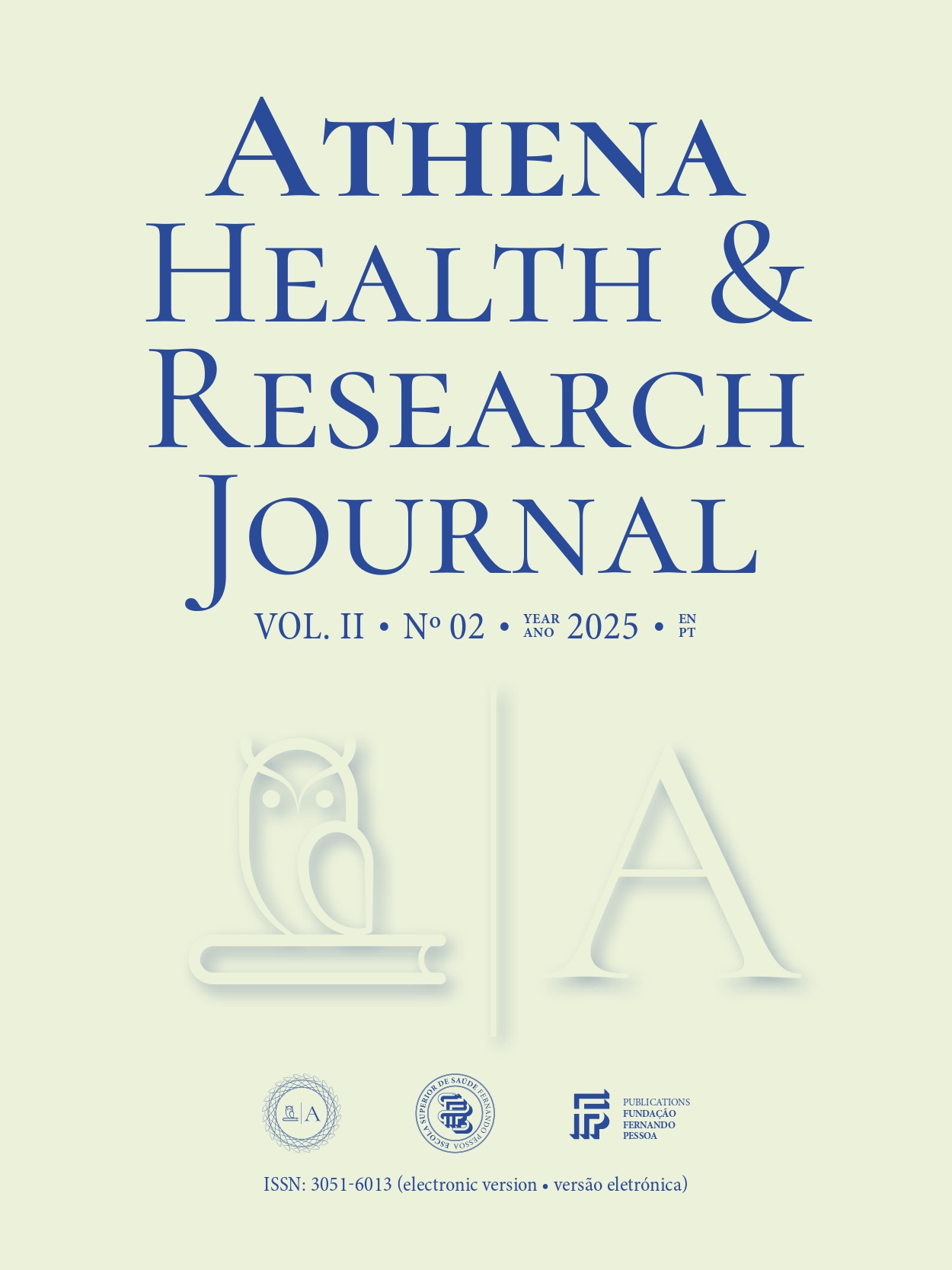Psychometric Properties of the European Portuguese Version of the London Chest Activities of Daily Living
DOI:
https://doi.org/10.62741/ahrj.v2i2.44Keywords:
Chronic obstructive pulmonary disease, Activities of daily living, Psychometrics, Burden of diseaseAbstract
Introduction: Assessing the capacity for activities of daily living in chronic obstructive pul-monary disease (COPD) patients allows us to determine the limitations imposed by the disease. Prior to this study, the version of the London Chest Activities of Daily Living (LCADL) com-monly used in Portugal was the Brazilian adaptation.
Objective: To translate, adapt, and validate the LCADL for the European Portuguese popula-tion and culture.
Methodology: Translation and cultural adaptation of the LCADL was performed, followed by a multicentric cross-sectional study for validation. A rehabilitation nurse administered the LCADL-PT and 50% of participants were invited to repeat it two weeks later for reliability. The results of the LDCAL-PT were compared with those of the one-minute sit-to-stand test and the St. George Respiratory Questionnaire for concurrent validity purposes.
Results: 107 participants diagnosed with COPD were enrolled; 80 (74.8%) were male, and the mean age was 67.8±7.9 years. A statistically significant negative correlation was found between the one-minute sit-to-stand and the LCADL-PT total score (r=-0.281, p=0.004), and a signifi-cant correlation was found with each of the SGRQ domains, as well as with the total score (symptoms: r=0.230, p=0.017; activity: r=0.428, p<0.001; impact: r=0.341, p<0.001; total: r=0.416, p<0.001). The internal consistency obtained was 0.901, and the intraclass correlation coefficient was 0.898.
Conclusion: The European Portuguese version of the LCADL has good psychometric properties and can be considered equivalent to the original English version, in terms of psychometric properties. These results support the use of this instrument both in clinical and research settings to evaluate the impact of COPD on ADL.
References
Soriano JB, Kendrick PJ, Paulson KR, et al. Prevalence and attributable health burden of chronic respiratory diseases, 1990–2017: a systematic analysis for the Global Burden of Dis-ease Study 2017. Lancet Respir Med. 2020;8(6):585-596. doi:10.1016/S2213-2600(20)30105-3 DOI: https://doi.org/10.1016/S2213-2600(20)30105-3
Halpin DMG, Celli BR, Criner GJ, et al. The GOLD Summit on chronic obstructive pulmonary disease in low- and middle-income countries. Int J Tuberc Lung Dis. 2019;23(11):1131-1141. doi:10.5588/IJTLD.19.0397 DOI: https://doi.org/10.5588/ijtld.19.0397
European Respiratory Society. European Lung White Book. (Gibson GJ, Loddenkemper R, Sibille Y, Lundbäck B, eds.).; 2013. Accessed April 24, 2022. https://www.erswhitebook.org/chapters/
Global Initiative for Chronic Obstructive Lung Disease. 2022 GOLD Reports - Global Initiative for Chronic Obstructive Lung Disease - GOLD.; 2021. Accessed April 24, 2022. https://goldcopd.org/2022-gold-reports-2/
Terzikhan N, Verhamme KMC, Hofman A, Stricker BH, Brus-selle GG, Lahousse L. Prevalence and incidence of COPD in smokers and non-smokers: the Rotterdam Study. Eur J Epi-demiol. 2016;31(8):785-792. doi:10.1007/S10654-016-0132-Z DOI: https://doi.org/10.1007/s10654-016-0132-z
Stanaway JD, Afshin A, Gakidou E, et al. Global, regional, and national comparative risk assessment of 84 behavioural, envi-ronmental and occupational, and metabolic risks or clusters of risks for 195 countries and territories, 1990-2017: a systematic analysis for the Global Burden of Disease Study 2017. Lancet. 2018;392(10159):1923-1994. doi:10.1016/S0140-6736(18)32225-6 DOI: https://doi.org/10.1016/S0140-6736(18)32225-6
Iheanacho I, Zhang S, King D, Rizzo M, Ismaila AS. Economic Burden of Chronic Obstructive Pulmonary Disease (COPD): A Systematic Literature Review. Int J Chron Obstruct Pulmon Dis. 2020;15:439. doi:10.2147/COPD.S234942 DOI: https://doi.org/10.2147/COPD.S234942
Hurst JR, Skolnik N, Hansen GJ, et al. Understanding the im-pact of chronic obstructive pulmonary disease exacerbations on patient health and quality of life. Eur J Intern Med. 2020;73:1-6. doi:10.1016/J.EJIM.2019.12.014 DOI: https://doi.org/10.1016/j.ejim.2019.12.014
Kharbanda S, Anand R. Health-related quality of life in pa-tients with chronic obstructive pulmonary disease: A hospital-based study. Indian J Med Res. 2021;153(4):459-464. doi:10.4103/IJMR.IJMR_1812_18 DOI: https://doi.org/10.4103/ijmr.IJMR_1812_18
Kaptain RJ, Helle T, Patomella AH, Weinreich UM, Kottorp A. New Insights into Activities of Daily Living Performance in Chronic Obstructive Pulmonary Disease. Int J Chron Obstruct Pulmon Dis. 2021;16:1-12. doi:10.2147/COPD.S264365 DOI: https://doi.org/10.2147/COPD.S264365
Cruz J, Marques A, Figueiredo D. Impacts of COPD on family carers and supportive interventions: a narrative review. Health Soc Care Community. 2017;25(1):11-25. doi:10.1111/HSC.12292 DOI: https://doi.org/10.1111/hsc.12292
Horner A, Burghuber OC, Hartl S, et al. Quality of Life and Limitations in Daily Life of Stable COPD Outpatients in a Real-World Setting in Austria - Results from the CLARA Project. Int J Chron Obstruct Pulmon Dis. 2020;15:1655-1663. doi:10.2147/COPD.S252033 DOI: https://doi.org/10.2147/COPD.S252033
Garrod R, Bestall JC, Paul EA, Wedzicha JA, Jones PW. Devel-opment and validation of a standardized measure of activity of daily living in patients with severe COPD: the London Chest Ac-tivity of Daily Living scale (LCADL). Respir Med. 2000;94(6):589-596. doi:10.1053/RMED.2000.0786 DOI: https://doi.org/10.1053/rmed.2000.0786
Direção-Geral da Saúde. Programas de Reabilitação Respirató-ria nos Cuidados de Saúde Primários. Published online 2019. Accessed April 24, 2022. https://www.dgs.pt/directrizes-da-dgs/orientacoes-e-circulares-informativas/orientacao-n-0142019-de-070820191.aspx
Pitta F, Probst VS, Kovelis D, et al. Validation of the Portuguese version of the London Chest Activity of Daily Living scale (LCADL) in chronic obstructive pulmonary disease patients. Rev Port Pneumol. 2008;14(1):27-47. doi:10.1016/s0873-2159(15)30217-8 DOI: https://doi.org/10.1016/S0873-2159(15)30217-8
Epstein J, Santo RM, Guillemin F. A review of guidelines for cross-cultural adaptation of questionnaires could not bring out a consensus. J Clin Epidemiol. 2015;68(4):435-441. doi:10.1016/j.jclinepi.2014.11.021 DOI: https://doi.org/10.1016/j.jclinepi.2014.11.021
Eremenco S, Pease S, Mann S, Berry P. Patient-reported out-come (PRO) consortium translation process: Consensus devel-opment of updated best practices. J Patient Rep Outcomes. 2018;2. doi:10.1186/s41687-018-0037-6 DOI: https://doi.org/10.1186/s41687-018-0037-6
Prakash V, Shah S, Hariohm K. Cross-cultural adaptation of patient-reported outcome measures: A solution or a problem? Ann Phys Rehabil Med. 2019;62(3):174-177. doi:10.1016/j.rehab.2019.01.006 DOI: https://doi.org/10.1016/j.rehab.2019.01.006
Kim S, Won CW. How can we evaluate disability without bias? Ann Geriatr Med Res. 2020;24(2):152-153. doi:10.4235/AGMR.20.0033 DOI: https://doi.org/10.4235/agmr.20.0033
Tirodkar MA, Song J, Chang RW, Dunlop DD, Chang HJ. Ra-cial and Ethnic Differences in Activities of Daily Living Disabil-ity Among the Elderly: The Case of Spanish Speakers. Arch Phys Med Rehabil. 2008;89(7):1262-1266. doi:10.1016/j.apmr.2007.11.042 DOI: https://doi.org/10.1016/j.apmr.2007.11.042
Dubbelman MA, Verrijp M, Facal D, et al. The influence of di-versity on the measurement of functional impairment: An in-ternational validation of the Amsterdam IADL Questionnaire in eight countries. Alzheimer’s and Dementia: Diagnosis, Assess-ment and Disease Monitoring. 2020;12(1). doi:10.1002/dad2.12021 DOI: https://doi.org/10.1002/dad2.12021
Mokkink LB, Prinsen CAC, Bouter LM, de Vet HCW, Terwee CB. The COnsensus-based Standards for the selection of health Measurement INstruments (COSMIN) and how to select an outcome measurement instrument. Braz J Phys Ther. 2016;20(2):105-113. doi:10.1590/BJPT-RBF.2014.0143 DOI: https://doi.org/10.1590/bjpt-rbf.2014.0143
Koufaki P, Mercer TH, Naish PF. Effects of exercise training on aerobic and functional capacity of end-stage renal disease pa-tients. Clin Physiol Funct Imaging. 2002;22(2):115-124. doi:10.1046/J.1365-2281.2002.00405.X DOI: https://doi.org/10.1046/j.1365-2281.2002.00405.x
Jones PW, Quirk FH, Baveystock CM, Littlejohns P. A self-complete measure of health status for chronic airflow limita-tion. The St. George’s Respiratory Questionnaire. Am Rev Respir Dis. 1992;145(6):1321-1327. doi:10.1164/AJRCCM/145.6.1321 DOI: https://doi.org/10.1164/ajrccm/145.6.1321
White M. Sample size in quantitative instrument validation studies: A systematic review of articles published in Scopus, 2021. Heliyon. 2022;8(12):e12223. doi:10.1016/J.HELIYON.2022.E12223 DOI: https://doi.org/10.1016/j.heliyon.2022.e12223
Garrod R, Paul EA, Wedzicha JA. An evaluation of the reliabil-ity and sensitivity of the London Chest Activity of Daily Living Scale (LCADL). Respir Med. 2002;96(9):725-730. doi:10.1053/RMED.2002.1338 DOI: https://doi.org/10.1053/rmed.2002.1338
Mokkink LB, Prinsen CA, Patrick DL, et al. COSMIN Study Design Checklist for Patient-Reported Outcome Measurement Instruments.; 2019. Accessed December 30, 2024. www.cosmin.nl
Choi JT, Seo JH, Ko MH, Park SH, Kim GW, Won YH. Valida-tion of Korean Version of the London Chest Activity of Daily Living Scale in Patients With Chronic Obstructive Pulmonary Disease. Ann Rehabil Med. 2018;42(2):329-335. doi:10.5535/ARM.2018.42.2.329 DOI: https://doi.org/10.5535/arm.2018.42.2.329
Saka S, Savcı S, Kütükcü EÇ, et al. Validity and Reliability of the Turkish Version of the London Chest Activity of Daily Living Scale in Obstructive Lung Diseases. Turk Thorac J. 2020;21(2):116-121. doi:10.5152/TURKTHORACJ.2019.18155 DOI: https://doi.org/10.5152/TurkThoracJ.2019.18155
Beaumont M, Couturaud F, Jego F, et al. Validation of the French version of the London Chest Activity of Daily Living scale and the Dyspnea-12 questionnaire. Int J Chron Obstruct Pulmon Dis. 2018;13:1399-1405. doi:10.2147/COPD.S145048 DOI: https://doi.org/10.2147/COPD.S145048
Ozalevli S, Ozden A, Itil O, Akkoclu A. Comparison of the Sit-to-Stand Test with 6 min walk test in patients with chronic obstructive pulmonary disease. Respir Med. 2007;101(2):286-293. doi:10.1016/J.RMED.2006.05.007 DOI: https://doi.org/10.1016/j.rmed.2006.05.007
Bohannon RW, Crouch R. 1-Minute Sit-to-Stand Test: Systematic review of procedures, performance, and clinimetric properties. J Cardiopulm Rehabil Prev. 2019;39(1):2-8. doi:10.1097/HCR.0000000000000336 DOI: https://doi.org/10.1097/HCR.0000000000000336
Vaidya T, Chambellan A, de Bisschop C. Sit-to-stand tests for COPD: A literature review. Respir Med. 2017;128:70-77. doi:10.1016/J.RMED.2017.05.003 DOI: https://doi.org/10.1016/j.rmed.2017.05.003
Downloads
Published
Issue
Section
License
Copyright of published papers is assigned to the Journal, but all content is licensed under the terms of Creative Commons Non-comercial 4.0 International License. Thus users are allowed to read, download, copy, distribute, print, search, or link to the full texts of the articles, or use them for any other lawful purpose, without asking prior permission from the publisher or the author. This is in accordance with the BOAI definition of open access.














